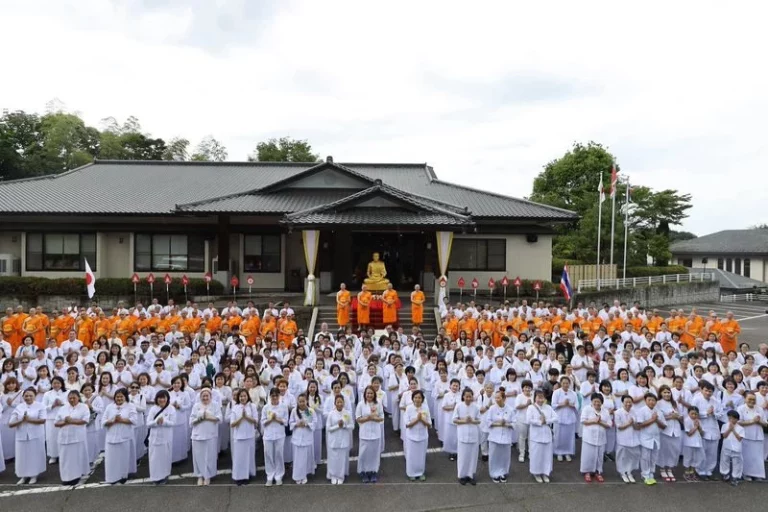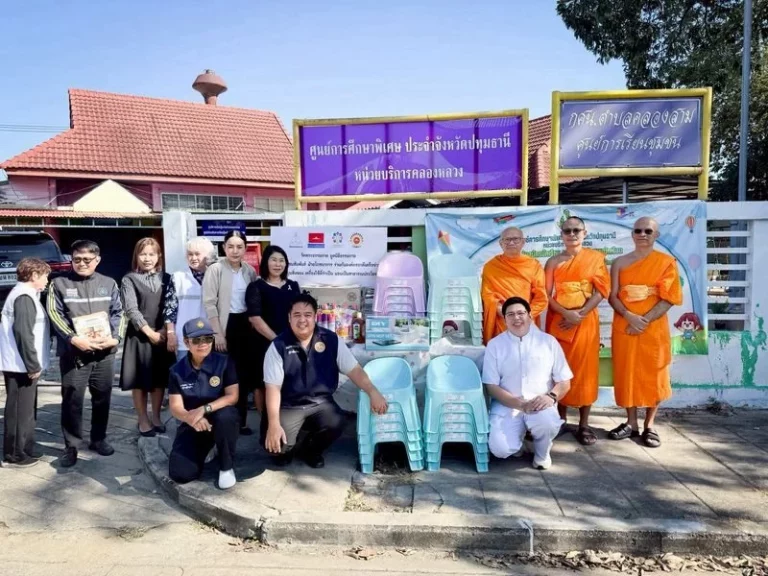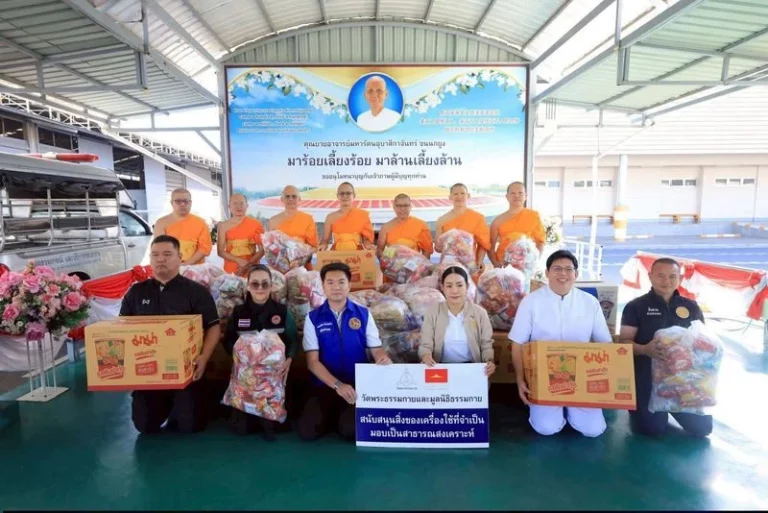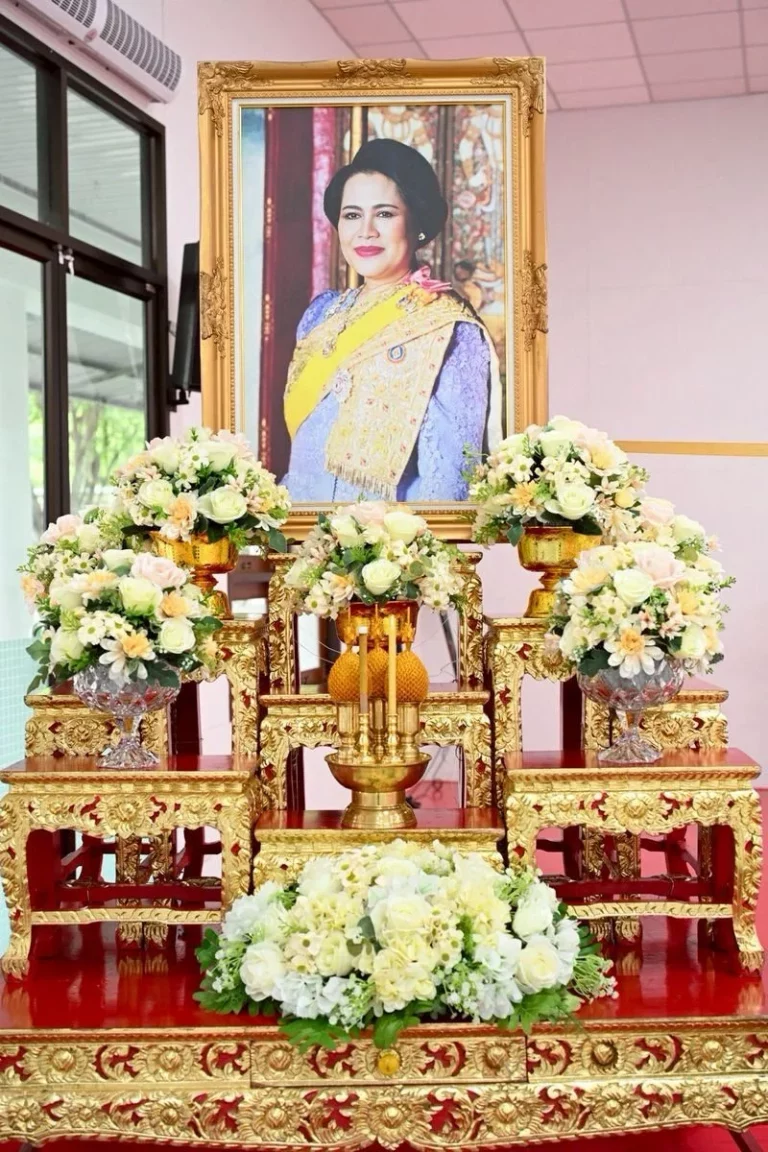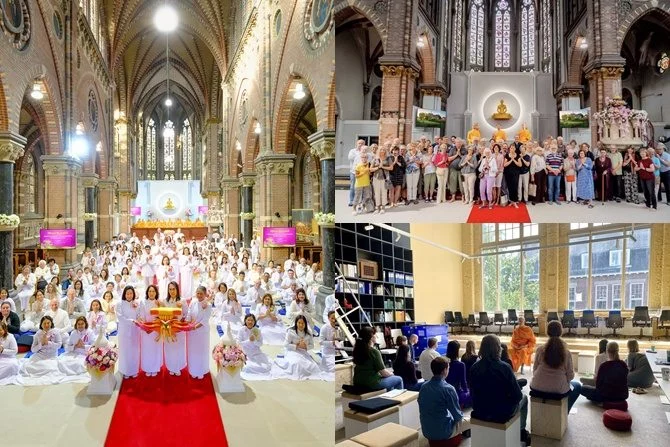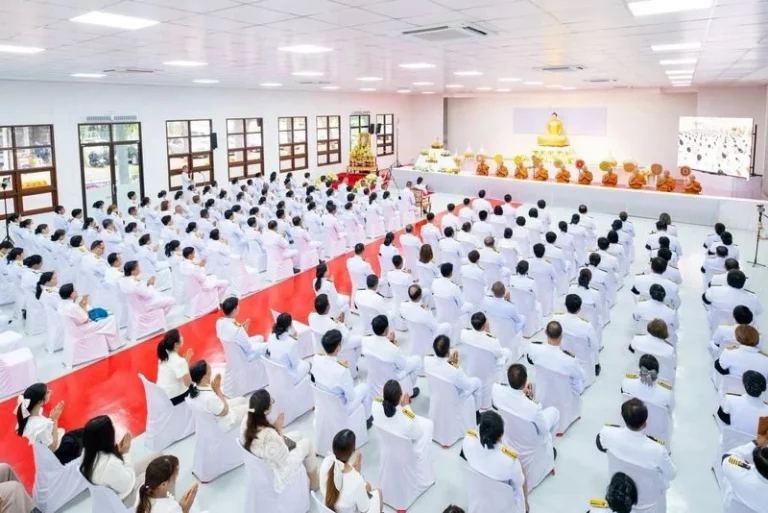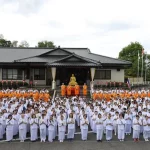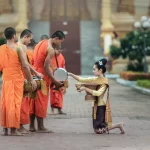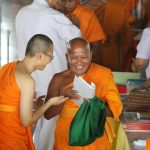From no land to a large tract of land
From fallow fields to a graceful Buddhist temple
From 1 Bhikku to tens to hundreds to a thousand and increasing
From 100 laypeople to 1,000, 10,000, 100,000 and 1 million in the future
Four decades have gone past since Wat Phra Dhammakaya was founded. Wat Phra Dhammakaya’s aim has always been to propagate Buddhism and Vijja Dhammakaya, which is the source of humanity’s peace and happiness.
In the beginning, there were only extensive fields under the hot sun with no trees or buildings. And at night, there was only the star-filled sky.
On Magha Puja Day, February 20, 2513 B.E., Phrathepyanmahamuni (Luang Por Dhammajayo, who had just spent a year in the monkhood), Master Nun Chand Khonnokyoong (61 years old), and their followers came together to commence the construction of a meditation center. The land for the meditation center covered 196 rai and was donated by Lady Prayad Pattayapongsavisuttatibodi. The meditation center became Wat Phra Dhammakaya on April 29, 2524 B.E.
At the start of the construction, Master Nun Chand Khonnokyoong had just 3,200 baht. This was no different from starting with nothing at all. One of her followers asked, “How can we build a temple with this small sum of money?” Master Nun Chand Khonnokyoong or more frequently referred to as Khun Yai said, “If we were to teach a person to be good, decent, and devoted to Buddhism, how much would it cost?” This follower answered, “I am not sure if 100 million baht would be enough.” Khun Yai said, “Well then, right now I have in front of me 11 such individuals. It means that I have now at my disposal no less than 1 billion baht so I have no doubt that I will be able to get this temple built.”
At the same time that the construction was going on, the Lord Buddha’s Teachings were being taught to the people according to the concept, “Build a real temple. Teach the monks to be righteous monks. Develop good and decent people.”
Every bit of land, every building, every merit-making activity, and every good thing that has ever come out of this temple are not the work of any one individual but they are the work of dedicated monks, novices, and laypeople. The founding team members of the temple had to have possessed extraordinary vision, unshakable faith, persistence, and patience to be able to realize the dream of building the kind of temple that Wat Phra Dhammakaya is today.
Our Great Master
It was our two great Masters’ aspiration that gave birth to Wat Phra Dhammakaya: Phramonkolthepmuni (Sodh Candasaro) or Luang Pu Wat Paknam, the Discoverer of Vijja Dhammakaya, and Master Nun Chand Khonnokyoong or Khun Yai, the founder of Wat Phra Dhammakaya. Luang Pu, Khun Yai and Phrathepyanmahamuni (Luang Por Dhammajayo), the Abbot of Wat Phra Dhammakaya share the same wish to spread the Lord Buddha’s Teachings to every corner of the world so that humanity can know lasting inner peace and world peace.
Building the Temple According to the Lord Buddha’s Instruction
Luang Por Dhammajayo, Khun Yai, and their followers have worked very hard together to build Wat Phra Dhammakaya according to the concept, “Build a real temple. Train the monks to be righteous monks. Develop good and decent people.” This concept was derived from the Lord Buddha’s Teachings on Patirupadesa-4: How to build the kind of quality temple that can attract people to come and practice the Dhamma at the temple for their own benefit, for the good of the general public, and for Buddhism’s growth.
Patirupadesa-4 as Applied to Wat Phra Dhammakaya:
- The Temple: The grounds of Wat Phra Dhammakaya are beautiful, cool, pleasant, clean, and tidy. It is a place that makes people feel comfortable and relaxed.
- Food: Wat Phra Dhammakaya’s refectory prepares food for everyone attending the temple and serves it to them in a speedy fashion. The refectory staff also tends with care and respect to the food offered to the monks by the laypeople.
- People: Wat Phra Dhammakaya’s personnel are well-trained, courteous, friendly, and service-minded. They study the Dhamma and practice meditation regularly. They are the model of goodness and decency.
- Dhamma: When people attend Wat Phra Dhammakaya, they must not return home empty-handed in that they must have the opportunity to study the Dhamma in such a way that they can apply it in their daily life. Wat Phra Dhammakaya also offers morality training courses for the personnel of government offices and educational institutions as well as the general public.
Any temple built with the Lord Buddha’s instruction in mind plays an important role in attracting more and more people to the temple. It is for this reason that an ever increasing number of people are coming to practice the Dhamma at Wat Phra Dhammakaya. It just goes to show how a large number of people do want to attend the temple to practice the Dhamma. It remains for each temple to be well-maintained, clean, cool, pleasant, and equipped with well-trained and quality personnel. And last but not least, each temple must develop modern methods for propagating the Dhamma so that it can fulfill its role of teaching the Dhamma to the people.
Building a Great Temple through the Power of Faith
The size of Wat Phra Dhammakaya went from 196 rai to 2,000 rai in 2527 because Luang Por Dhammajayo wanted the temple to be large enough for all the work that it planned to do in the future. The propagation of Buddhism to every corner of the world can benefit everyone in Thailand and the entire world. The expansion of Wat Phra Dhammakaya and all of its work have been supported physically and financially by the laypeople who understand the need for the increasing size of the temple.
As a result, Wat Phra Dhammakaya can now accommodate hundreds of thousands of people or more who are now coming and will in the future come to practice the Dhamma at Wat Phra Dhammakaya.
Since every baht spent on building Wat Phra Dhammakaya is donated by the laypeople, everything having to do with the construction and maintenance of every part of the temple must be based on the principle, “Lowest cost, highest usage, and durability.” It means that only necessary structures are built and once they were built they must be utilized to the fullest extent. They must be durable. They must be easy and economical to maintain. Temple personnel and temple goers alike are taught to feel a sense of ownership in the temple such that everyone can help take good care of everything in the temple. This way, donors can reap the maximum merit from their donations.
The Temple’s Achievements to Date
During the past 40 years, Wat Phra Dhammakaya has not only built necessary structures but also developed people. It has produced righteous monks to perpetuate Buddhism. It has instilled morality in people of every age and gender. It has extended some projects to different countries to help propagate Buddhism there. These undertakings give the people in these countries the opportunities to study the Lord Buddha’s Teachings and practice meditation. At the same time, they learn about the true objective of human life in that everyone is here to accumulate merit and pursue Perfections. Practicing the Lord Buddha’s Teachings increases the quality of life. It is also the way to revive world morality.
New Year Day Food Offering and Year-End Dhutanga
About 3 – 5 days before each year-end, Buddhists everywhere come to undertake Dhutanga and usher in the new year at Wat Phra Dhammakaya. In the first morning of the new year, they offer food to more than 10,000 venerable monks, observe the Eight Precepts, and practice meditation in preparation for every good thing that will come into their lives in the year ahead.
Mass Ordination of 100,000 Monks from Every Village in Thailand
This project has been made possible by the support of the entire Sangha Community, the Committee on Education, Religion, Arts and Culture Group, the House of Representatives, along with more than 25 organizations. This project is the continuation of the Mass Ordination of 7,000 monks from 7,000 Tambon.
This mass ordination project took place between January 19 and March 8, 2553 B.E. Ordinands were ordained together as novices at Wat Phra Dhammakaya. The novices were subsequently ordained as monks and underwent religious training at different temples all over Thailand. This was the largest mass ordination in Thailand’s recorded history. More importantly, many monks were inspired to remain in the monkhood to help perpetuate Buddhism causing the number of monks in the Sangha Community to increase.
Renunciation Practice of 100,000 Upasikas
This program took place on March 8 – 15, 2553 B.E. During the program, women practiced renunciation, performed wholesome deeds, and learned about the Buddhist Ideal and morality. The women who undertook the training can play an important role in protecting Buddhism and reviving world morality.
V-Stars (Virtuous Stars) Project for World Morality Revival
This project aims to instill morality in young people. It does this by teaching them to cultivate certain necessary virtues so that they can be responsible not just for themselves but for the community as well. Smart and good children are the future and the hope of the family, society, and country. They are also the future model of morality.
Wat Phra Dhammakaya has put in place a morality standard appraisal, a Buddhist culture contest and an award presentation ceremony. These programs have been participated by many educational institutions at all levels nationwide. The first Award Presentation Ceremony took place on May 19, 2551 B.E. on the grounds of the Great Dhammakaya Cetiya. The ceremony has been organized four times so far and each time it was participated by hundreds of thousands of V-Stars.
The Lighting of Candles on Magha Puja Day
About 2,500 years ago, the Lord Buddha and 1,250 Arahats had a meeting at Veluvana Temple in which the Lord Buddha described the Buddhist Ideal, the Buddhist Principle, and the method of spreading Buddhism. In order to commemorate this important event, Buddhists of later times have come together to light candles as homage paid to the Lord Buddha on the day called Magha Puja Day.
Each year, Buddhists all over the world come to Wat Phra Dhammakaya to participate in Magha Puja Day activities. During the day, they earn merit by making a food-offering, practicing meditation, offering alms to the Sangha, etc. In the evening, everyone congregates at the grounds of the Great Dhammakaya Cetiya. They circumambulate the Cetiya, light more than 100,000 candles as homage paid to the Lord Buddha, and make a resolute wish together for world peace.
The Casting of Personal Dhammakaya Images
On World Meditation Day, everyone is reminded of the goal of attaining Dhammakaya because the attainment of Dhammakaya leads to inner peace and world peace respectively. Making the Lord Buddha’s Teachings known to everyone in the world and the creation of world peace remains the life-goal of Phrathepyanmahamuni, the Abbot of Wat Phra Dhammakaya.
On Earth Day April 22, Buddhists worldwide come to Wat Phra Dhammakaya to attend the Personal Dhammakaya Image Casting Ceremony. These Dhammakaya Images are to be enshrined in the Great Dhammakaya Cetiya. On the same day, venerable monks from more than 30,000 temples are invited to Wat Phra Dhammakaya to receive alms from the laypeople.
Offering Alms to Temples All Over Thailand
Since 2002, the abbots of more than 30,000 temples nationwide especially the abbots or the representatives of 286 temples in the four southern provinces, who are putting their lives on the line for Buddhism, are invited to Wat Phra Dhammakaya to receive alms from the laity. On such occasions, Buddhists come together as one to perform wholesome deeds and earn an enormous amount of merit. They come together in strength to support and protect Buddhism.
The Offering of Food to Two Million Monks from 77 Provinces in Thailand
This project not only revives morality and the food-offering tradition but it also serves to unite Buddhists and help our monks and novices in the four southern provinces who cannot go on their alms-round due to terrorist activity. Donated food and other goods are sent to help disaster victims as well.
Mass Ordination of International Monks
This event is organized especially for foreigners who are interested in learning about the monastic lifestyle. The program lasts about one month and is held in Chinese, English, Japanese, etc.
Participants can learn first-hand what it is like to be a monk. During the training period, they can practice meditation, study the Lord Buddha’s Teachings, develop patience and persistence, learn to live with people from different cultures, work boldly toward their goal, and develop Right View, right knowledge, and wisdom.
The Middle Way Meditation Program
This is a meditation program specifically designed for foreigners who wish to learn about meditation practice. Instructions are given by qualified teaching monks in English, Chinese, Japanese, etc. Participants have the opportunity to practice meditation in a favorable environment and garner happiness from their meditation practice. It is one of life’s exceptional experiences.
If you are interested in joining the program, you can find more information at
www.mdwmeditation.org for English and
www.dmcchinese.tv/zhongdao for Chinese.
Meditation programs are offered regularly here in Thailand and at different branches all over the world in order to teach people about meditation practice, and the incomparable joy of attaining Dhammakaya.
Academic Collaboration with Foreign Organizations
On July 16, 2551 B.E., Dhammachai Institute’s Buddhist Studies Department and Chwien Chang University’s Theology Department in Taiwan signed an academic agreement to develop together better learning and teaching methods and elevate academic development standard.
On August 27, 2552 B.E. at Wat Phra Dhammkaya, Peking University agreed to translate the Tripitaka from Pali into modern Chinese. This Tripitaka version is called “Beida-Dhammachai Pali Series” (BDP)
On September 29, 2553 B.E. at Wat Phra Dhammakaya, DMC signed an agreement with Sri Lanka’s Buddhist TV Channel, MOU, to exchange broadcasting programs with each other. The Siamvongse Nikaya Supreme Patriarch presided over the signing. Initially, MOU will air certain DMC programs that are of interest to the people of Sri Lanka for two hours each day.
On August 27, 2554 B.E. at Wat Phra Dhammakaya, an academic agreement was signed with three institutions: the Library of Oxford University Bodleian, King’s College London University, and University College Cork. Wat Phra Dhammakaya has agreed to fund their research under the subject of “Theravada Buddhism: Continuity and Diversity”.
On Saturday, February 23, 2013, the Tripitaka Research Group of Wat Phra Dhammakaya, the Dhammakaya Foundation along with 10 universities from around the world, organized a seminar and exhibits on the Tripitaka-Pali under the theme “Perpetuation of the Lord Buddha’s Teachings: During Lord Buddha’s Time to the Present Days” at Thailand Science Park Convention Center in Pathumthani.
During the seminar there were exhibitions and lectures from a panel of world renowned Pali experts such as Professor Richard Gombrich from Oxford University; Professor Oskar von Hinüber, an expert on Pali and ancient manuscripts; Professor Rupert Gethin, President of the Pali Text Society; and Professor Masahiro Shimoda from University of Tokyo. Professor Shimoda presented discussions on the topics: “The transmission of Dhamma Through Oral Tradition”; “The Transmission of Dhamma Through Palm-leaf Manuscript”; “The Transmission of Dhamma Through Printed Editions of the Tipitaka”; and “The Transmission of Dhamma in the Digital Age.”
The Tripitaka Research Group of Wat Phra Dhammakaya organized this event as an effort to preserve the ancient manuscripts digitally, a more durable format, and to create a database of the Tripitaka to assist the continued research of Buddhism throughout the world. At the event, the Tripitaka Research Group discussed their research results on ancient Buddhist manuscripts from every tradition and presented the “Dhammachai Tripitaka (preliminary edition)” in order to corral opinions and recommendations from experts that can be applied to producing the most complete text.
Dhutanga Monks Retraced Luang Pu’s Footsteps behind Luang Pu’s Gold Image
In 2011, the worst floods struck Thailand causing tremendous damage to the country and the people were in a low spirit. In order to give comfort and cheer to floods victims and bless the country and its people with great merit, Wat Phra Dhammakaya, the Dhammakaya Foundation along with more than 25 organizations had worked together to organize Dhammachai Dhutanga. The event took place on January 2 – 25, 2012. More than 1,127 venerable monks undertook Dhutanga to retrace the footsteps of Luang Pu, the Great Master of Vijja Dhammakaya. The trek went through the provinces of Patumthani, Ayutthaya, Suphanburi, Nakorn Pathom, Nonthaburi, and Bangkok. The total distance of the trek was more than 365 kilometers. At each rest stop, our Dhutanga monks chanted, practiced meditation, and spread love and kindness to all living beings. Everywhere the Dhutanga monks went people and students came to welcome them by lining their path with rose petals.
In retracing Luang Pu’s footsteps, our Dhutanga monks visited the six important places in Luang Pu’s life. These include 1) Luang Pu’s birthplace, 2) the place where Luang Pu entered the monkhood, 3) the place where Luang Pu attained the Dhamma (Wat Boatbon, Bang Kuvieng), 4) the place where Luang Pu taught Vijja Dhammakaya for the first time (Wat Bangpla), 5) the place where Luang Pu spent the rest of his life researching Vijja Dhammakaya (Wat Paknam), and 6) the place where Vijja Dhammakaya is propagated (Wat Phra Dhammakaya). Luang Pu’s Gold Image will be enshrined in each of these six places as a reminder to the people of future generations of Luang Pu’s precious gift to humanity. Having learnt about Luang Pu’s history, they will be inspired to study and practice Luang Pu’s teachings for the sake of their happiness and prosperity.
As a way to demonstrate utmost honor and appreciation for Luang Pu – the Great Master of Vijja Dhammakaya – and his discovery of the Dhammakaya Knowledge, the Most Venerable Phrathepyanmahamuni (Luang Por Dhammajayo Bhikkhu) – abbot of Wat Phra Dhammakaya, along with faithful devotees have collectively contributed to the casting of Luang Pu’s Gold Images that will be enshrined at the six important places in Luang Pu’s life.
On April 2-6, 2012, there was a procession to enshrine the Gold Image of Luang Pu at the Phramahacetiya Maharajamongkol Pagoda at Wat Paknam Bhasicharoen in Bangkok, the location where the initial propagation of the Dhammakaya Knowledge was established. Thousands of lay devotees came to pay reverence to Luang Pu’s Gold Image and to welcome the 1,500 Dhutanga monks by lining the entire path with rose petals.
On March 25-26, 2013, another procession was held to enshrine the second Gold Image of Luang Pu at Wat Song Pi Nong in Suphanburi, the place where Luang Pu entered the monkhood. Great numbers of supporters convened to welcome Luang Pu’s Gold Image and the 1,500 Dhutanga monks by paving the path with marigold petals.
The great undertaking of the Dhutanga aimed to bring great fortune to Wat Paknam Bhasicharoen through the enshrinement of Luang Pu’s Gold Image and to cultivate virtues in Thailand.
Practicing Meditation Together via the Internet
Peace Revolution was initiated in order to employ the high speed Internet as a media for teaching meditation to all the people who have access to it. This project allows people especially the new generation people in every corner of the world to practice meditation together at the specified time. It is also the platform for exchanging ideas and meditative experiences.
Social Welfare
The Dhammakaya Foundation under the leadership of Phrathepyanmahamuni (Luang Por Dhammajayo) has in a most timely manner given relief packages to victims of floods, violent storms, earthquakes, sudden cold spells…as well as spiritual support. This was most evident during the worst floods in Thailand in 2011.
During the 2011 floods, the Dhammakaya Foundation had given out more than 5 million relief packages to floods victims all throughout the months of the floods and up until the time when the situation began to improve.
Dedication of Merit to Tsunami Victims
On January 5, 2005 at Phuket and on January 19, 2005 at Pattalung Province, the Dhammakaya Foundation along with several governmental organizations and non-governmental organizations had organized a candle lighting ceremony as homage paid to the Lord Buddha. The merit earned from this activity was then dedicated to the people who had perished as a result of the Tsunami. At the same time, aid was given to the people who had survived the Tsunami.
Dhammakaya Open University (DOU)
Dhammakaya Open University is a private Buddhist university that offers long-distance learning based on the Higher Education Act of California, U.S.A.
DOU emphasizes the combination of education and lifestyle. DOU enables its students to have a good understanding of both the theoretical part and the practical part of the Lord Buddha’s Teachings. At DOU, students learn about the reality of life and the different realms of existence. The Dhamma knowledge gained allows them to benefit themselves as well as everyone around them. DOU gives people the opportunity to gain a college education regardless of their gender, age, religious belief, and ethnicity.
The Path to Progress Project
This project was initiated in 2525 B.E. in order to promote Dhamma education and the application of Dhamma knowledge to one’s daily life. Young participants range from students at the kindergarten level all the way to the undergraduate level. Other participants include soldiers, policemen, and teachers. His Majesty the king has kindly bestowed an honor shield to each year’s top national winner. This project has also received wide support from all concerned because everyone realizes the importance of youth to the future of our country and our world. Today, the project attracts around 500,000 participants annually and during the past 20 years, about ten million young people have benefited from this project.
In April 2543 B.E., this project was listed as a UNESCO Culture of Peace and Non-Violence.
World Peace Ethics Contest (World-PEC)
The contest is held at the same time in different countries in order to promote Dhamma education for people worldwide for the reason that Dhamma knowledge allows us to live life correctly. Dhamma knowledge enables us to create a warm and loving family, decrease social problems, and create peace and harmony in society.
International Cooperation
India
On July 19 – 26, 2553 B.E. in India, a program was organized for Buddhist men and women in India to practice renunciation. In addition, the lighting of floating lanterns was organized in different cities such as Mumbai, Kalyan, Nagpur, Murtijapur, Balaghat, and Ahmednagar. These activities are part of the effort to help revive Buddhism in India, restore Buddhist culture, create a network of virtuous friends, and promote the concept that economy and spirituality must go hand-in-hand.
Sri Lanka
The presentation of 222 Dhammakaya Images took place on June 13, 2551 B.E. at Bernard Aluviharaya ground. The President of the Sangha Assembly of Sri Lanka presided over the ceremony. And the event was attended by 2,000 monks from all over Sri Lanka as well as the ministers of different ministries, senators, and a large number of laypeople.
The World Peace Ethics Contest in Sri Lanka was held on August 15, 2553 B.E. by the Sri Lankan Department of Religion and Wat Phra Dhammakaya. The contest was held in more than 300 centers nationwide. Altogether there were 10,000 teams and 30,000 contestants. Today, the contest is participated by more than 20,000 teams and 60,000 contestants.
Nepal
The mass ordination program of 1,112 novices at Lumbini, Nepal was held on November 10 – 28, 2554 B.E. The ordination ceremony was attended by a large number of Nepalese and Thai people.
Bangladesh
The presentation of 250 Dhammakaya Images in Bangladesh took place on May 7, 2553 B.E. in Chittagong. The ceremony was attended by a large number of Buddhists as well as representatives of different temples. The front page of different newspapers was filled with news of the event.
On March 18, 2554 B.E., the World Peace Ethics Contest in Bangladesh was held for the first time. There were 10 exam centers, 509 teams and more than 1,500 contestants from four cities in the Chittagong area.
A program for Buddhist men and women in Bangladesh to practice renunciation was organized in Dhaka and Chittagong in June 2554 B.E. by the Dhammakaya Foundation, the World Fellowship of Buddhist Youth or WFBY, and Bouddha Juba Parisad (Young Buddhist Association of Bangladesh) or BBJP.
– In Dhaka, the program was from June 17 to June 22, 2554 B.E.
– In Chittagong, the program was from June 24 to June 30, 2554 B.E.
International Visakha Puja Day
Wat Phra Dhammakaya and the Dhammakaya Foundation celebrate Visakha Puja Day at Wat Phra Dhammakaya in Thailand and at its branches in Indonesia, Mongolia, Singapore, India, U.S.A., etc.
India
The Dhammakaya Foundation and the Kalpana Saroj Foundation organized a candle and floating lantern lighting event as homage paid to the Lord Buddha in the city of Karachi, India. Thousands of Indian people attended the merit-making event.
Singapore
Wat Phra Dhammakaya Singapore celebrates Visakha Puja by organizing an exhibition where people can bathe the Buddha Image, light the candle to worship the Holy Relics, receive blessings from listening to the monks’ chanting, practice meditation, etc. Monks from every Buddhist School in Singapore and people of other religious faiths are also invited to attend.
Malaysia
Every year in Penang, Malaysia, there is a Visakha Puja Day Procession. This activity has been organized every year for about 25 years now and this year the procession was along Burmah Road, Georgetown. The activity is organized by Penang Visakha Puja Day Committee under the supervision of the Malaysian Buddhist Society with the support of 33 organizations. The activity draws more than 6,000 people this year.
Mongolia
The Dhammakaya Foundation and the Peaceful Mind Foundation organized a candle and floating lantern lighting event as homage paid to the Lord Buddha at the National Stadium in the center of Ulan Bator. During the event, Mongolians pledged themselves as Buddhists. They chanted and practiced meditation together. The event was attended by senior Lamas and broadcasted live on television nationwide. Thousands of Mongolians attended the merit-filled event.
Indonesia
The Dhammakaya Foundation and the Warubi Society organized a Visakha Puja Day event at Borobudur. Monks from different Buddhist Schools and Buddhists all over Indonesia came together to practice meditation, chant, light candles and floating lanterns as homage paid to the Lord Buddha.
The United States
Wat Phra Dhammakaya California organizes an international Visakha Puja day event every year. Monks from different Buddhist Schools and Buddhists from different countries are invited to light candles, circumambulate the Buddha Image, chant, and practice meditation together.
Dhamma Programs via Satellite (DMC)
DMC or Dhamma Media Channel broadcasts its programs 24 hours a day to promote Dhamma knowledge and morality. These programs are produced by the Dhamma Education for the Environment Foundation. DMC offers a variety of interesting programs such as the Inner Dreams Kindergarten, Answers from Luang Por by Phrabhavanaviriyakhun (Luang Por Dattajeevo), Paying homage to the Great Dhammakaya Cetiya, meditation lessons, morning and evening chanting, DMC News, etc.
DMC gives everyone in the world the opportunity to practice meditation together and discover true happiness for himself. Meditation is usually led by Luang Por Dhammajayo. Meditation is something that can be practiced by anyone in his daily life. Meditation gives rise to inner peace and inner peace leads to world peace.
Many projects initiated and run by Wat Phra Dhammakaya have received international recognition such that different awards have been offered to Luang Por Dhammajayo, Wat Phra Dhammakaya, and the Dhammakaya Foundation over the years. Some of these awards are:
- A Mahatma Gandhi Medal for Peace from Akhil Bharat Rachanatmak Samaj
The medal was received on April 22, 2548 B.E. in recognition of Luang Por Dhammajayo’s dedicated effort in youth development for more than 40 years.
- World No Tobacco Day Awards 2004 from the World Health Organization
The award was received on May 31, 2547 B.E. in recognition of Luang Por Dhammajayo’s ongoing stop smoking campaign.
- Universal Peace Award from Buddhist leaders who attended the third WBSY meeting in Sri Lanka. The award was received on March 3, 2550 B.E. in recognition of Luang Por Dhammajayo’s outstanding work in propagating Buddhism.
- Honorary Shield from the representatives of the four southern provinces. The award was received on December 3, 2549 B.E. in recognition of Luang Por Dhammajayo’s effort to help floods victims in different provinces in 2549 B.E.
- Outstanding Radio and TV Stations for the promotion of Buddhism from the Supreme Patriarch of Thailand. The award was received on May 22, 2551 B.E. in recognition of DMC programs and their translation into English and Chinese. DMC started its 24 hours a day worldwide broadcast in 2545 B.E.
The 28th Telly Awards, U.S.A. Twelve awards were received on September 26, 2550 B.E. in recognition of DMC’s unique and quality Dhamma programs.
- The Senate Medal was received on February 23, 2548 B.E. in recognition of the memorial services organized for the Tsunami victims in Phuket on January 5, 2548 B.E. and in Phang-nga on January 19, 2548 B.E.
The Association for the Protection of Afghan Archaeology presented an honorific plaque to Most Venerable Phrathepyanmahamuni on February 25, 2013 in recognition of his tremendous support in the effort to protect and preserve an invaluable 2000-year-old ancient Buddhist site at Mes Aynak in Afghanistan.
Noble Peace Award from the World Buddhist Sangha Youth (WBSY) was presented to Most Venerable Phrathepyanmahamuni on February 25, 2013. The award was presented by Most Venerable Mugunuwela Anuruddha Thero, Secretary General of the WBSY, and Vice Admiral Jayanath Colombage, Commander of the Sri Lanka Navy, representing the Honorable Prime Minister of Sri Lanka.
In 44 years, everything has changed with time as it must. But the aspiration of Wat Phra Dhammakaya community has never changed. It continues to perpetuate the aspiration of Phramonkolthepmuni and Master Nun Chand Khonnokyoong, which is to spread Buddhism and Vijja Dhammakaya to every corner of the world. The Lord Buddha’s Teachings can create inner peace for all humankind, and encourage everyone to accumulate merit as provisions for the endless cycles of life, death, and rebirth until such time that Nibbana can be attained. Every human being is born on earth to embark upon the Path of Nibbana, accumulate merit, and pursue Perfections.




























